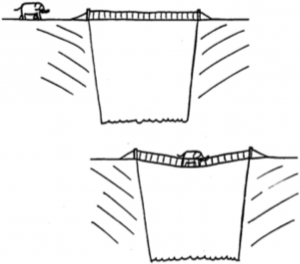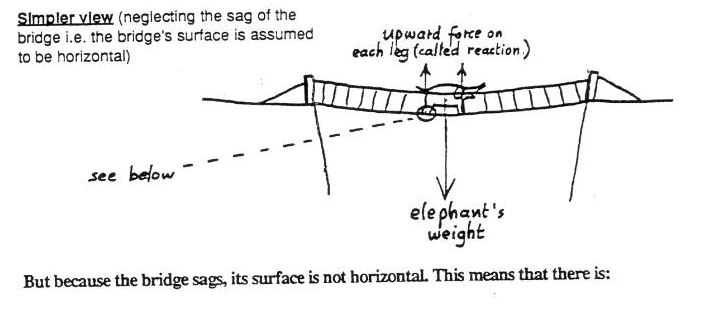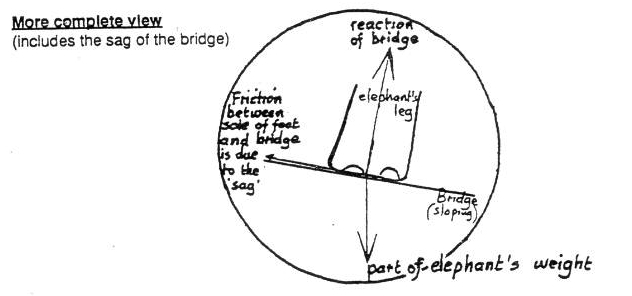Elephant on the Bridge/Lesson Document: Difference between revisions
JanetBlair (talk | contribs) No edit summary |
No edit summary |
||
| (20 intermediate revisions by 2 users not shown) | |||
| Line 1: | Line 1: | ||
This resource includes a simple explanation for teachers or older pupils of the forces acting on an elephant who is standing still on a rope bridge, followed by a simple question sheet for presentation to pupils. | |||
An interactive way of exploring this activity might be to have the children building a rope/string bridge and using a model elephant to stand on it. The children could either observe what happens and then discuss it or could film it and watch in time lapse to see exactly where the movement occurs in the bridge/elephant system. The latter would assist them in considering the direction of the forces acting as they would be able to see the direction of movements very clearly. | |||
=Explanation= | |||
The elephant walks out to the middle of the bridge and then becomes frightened so she stands quite still – the questions are about the second drawing – when the elephant is still. | |||
[[Image:Elephant_on_the_bridge.png|300x300px]] | |||
Focus questions: | Focus questions: | ||
# What forces (pushes/pulls) are there on the elephant? | |||
# What forces (pushes/pulls) are there on the bridge? | |||
# Any other forces (pushes/pulls) on the elephant or on the bridge? | |||
[[Image:simple view. | [[Image:simple view.jpeg|800x600px]] | ||
There are many forces acting on both the bridge and elephant in this situation. The explanation provided here is a simplified one which deals only with the forces acting on the elephant. | There are many forces acting on both the bridge and elephant in this situation. The explanation provided here is a simplified one which deals only with the forces acting on the elephant. | ||
The most obvious forces acting on the elephant are: | The most obvious forces acting on the elephant are: | ||
* The elephant’s weight pulling it down on to the bridge and making it sag. | |||
* The force of reaction from the bridge pushing upwards on the elephant’s feet (see insert for fuller explanation). | |||
[[Image:elephants foot.jpeg|800x800px]] | |||
Because the bridge sags, its surface is not horizontal. This means that there is: | |||
* friction between the elephant’s feet and the surface of the bridge. | |||
The net effect of all these forces acting on the elephant is to keep it stationary in the position shown in the picture. | The net effect of all these forces acting on the elephant is to keep it stationary in the position shown in the picture. | ||
The net force (or resultant force, as it is called by science) upon something is the sum total of all the various forces acting upon it, i.e. all these forces are added together and regarded as a single force. | The net force (or resultant force, as it is called by science) upon something is the sum total of all the various forces acting upon it, i.e. all these forces are added together and regarded as a single force. | ||
Since the elephant is stationary, there cannot be any net force acting on it, i.e. the resultant force on the elephant must be zero. | Since the elephant is stationary, there cannot be any net force acting on it, i.e. the resultant force on the elephant must be zero. | ||
Latest revision as of 16:31, 5 November 2012
This resource includes a simple explanation for teachers or older pupils of the forces acting on an elephant who is standing still on a rope bridge, followed by a simple question sheet for presentation to pupils.
An interactive way of exploring this activity might be to have the children building a rope/string bridge and using a model elephant to stand on it. The children could either observe what happens and then discuss it or could film it and watch in time lapse to see exactly where the movement occurs in the bridge/elephant system. The latter would assist them in considering the direction of the forces acting as they would be able to see the direction of movements very clearly.
Explanation
The elephant walks out to the middle of the bridge and then becomes frightened so she stands quite still – the questions are about the second drawing – when the elephant is still.
Focus questions:
- What forces (pushes/pulls) are there on the elephant?
- What forces (pushes/pulls) are there on the bridge?
- Any other forces (pushes/pulls) on the elephant or on the bridge?
There are many forces acting on both the bridge and elephant in this situation. The explanation provided here is a simplified one which deals only with the forces acting on the elephant. The most obvious forces acting on the elephant are:
- The elephant’s weight pulling it down on to the bridge and making it sag.
- The force of reaction from the bridge pushing upwards on the elephant’s feet (see insert for fuller explanation).
Because the bridge sags, its surface is not horizontal. This means that there is:
- friction between the elephant’s feet and the surface of the bridge.
The net effect of all these forces acting on the elephant is to keep it stationary in the position shown in the picture. The net force (or resultant force, as it is called by science) upon something is the sum total of all the various forces acting upon it, i.e. all these forces are added together and regarded as a single force.
Since the elephant is stationary, there cannot be any net force acting on it, i.e. the resultant force on the elephant must be zero.



